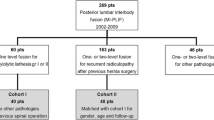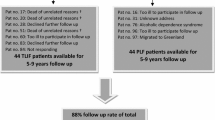Abstract
Purpose
Supporters of minimally invasive approaches for transforaminal lumbar interbody fusion (TLIF) have reported short-term advantages associated with a reduced soft tissue trauma. Nevertheless, mid- and long-term outcomes and specifically those involving physical activities have not been adequately studied. The aim of this study was to compare the clinical outcomes of mini-open versus classic open surgery for one-level TLIF, with an individualized evaluation of the variables used for the clinical assessment.
Methods
A prospective cohort study was conducted of 41 individuals with degenerative disc disease who underwent a one-level TLIF from January 2007 to June 2008. Patients were randomized into two groups depending on the type of surgery performed: classic open (CL-TLIF) group and mini-open approach (MO-TLIF) group. The visual analog scale (VAS), North American Spine Society (NASS) Low Back Pain Outcome instrument, Oswestry Disability Index (ODI) and the Short Form 36 Health Survey (SF-36) were used for clinical assessment in a minimum 3-year follow-up (36–54 months).
Results
Patients of the MO-TLIF group presented lower rates of lumbar (p = 0.194) and sciatic pain (p = 0.427) and performed better in daily life activities, especially in those requiring mild efforts: lifting slight weights (p = 0.081), standing (p = 0.097), carrying groceries (p = 0.033), walking (p = 0.069) and dressing (p = 0.074). Nevertheless, the global scores of the clinical questionnaires showed no statistical differences between the CL-TLIF and the MO-TLIF groups.
Conclusions
Despite an improved functional status of MO-TLIF patients in the short term, the clinical outcomes of mini-open TLIF at the 3- to 4-year follow-up showed no clinically relevant differences to those obtained with open TLIF.




Similar content being viewed by others
References
Harms JG, Jeszenszky D (1998) The unilateral transforaminal approach for posterior lumbar interbody fusion. Oper Orthop Traumatol 10:90–102. doi:10.1007/s00064-006-0112-7
Harms J, Rolinger H (1982) A one-stager procedure in operative treatment of spondylolistheses: dorsal traction-reposition and anterior fusion (author’s transl). Z Orthop Ihre Grenzgeb 120:343–347. doi:10.1055/s-2008-1051624
Rouben D, Casnellie M, Ferguson M (2011) Long-term durability of minimal invasive posterior transforaminal lumbar interbody fusion: a clinical and radiographic follow-up. J Spinal Disord Tech 24:288–296. doi:10.1097/BSD.0b013e3181f9a60a
Mehta VA, McGirt MJ, Garcés Ambrossi GL, Parker SL, Sciubba DM, Bydon A, Wolinsky JP, Gokaslan ZL, Witham TF (2011) Trans-foraminal versus posterior lumbar interbody fusion: comparison of surgical morbidity. Neurol Res 33:38–42. doi:10.1179/016164110X12681290831289
Tsutsumimoto T, Shimogata M, Ohta H, Misawa H (2009) Mini-open versus conventional open posterior lumbar interbody fusion for the treatment of lumbar degenerative spondylolisthesis: comparison of paraspinal muscle damage and slip reduction. Spine 34:1923–1928. doi:10.1097/BRS.0b013e3181a9d28e
Wang MY, Cummock MD, Yu Y, Trivedi RA (2010) An analysis of the differences in the acute hospitalization charges following minimally invasive versus open posterior lumbar interbody fusion. J Neurosurg Spine 12:694–699. doi:10.3171/2009.12.SPINE09621
Adogwa O, Parker SL, Bydon A, Cheng J, McGirt MJ (2011) Comparative effectiveness of minimally invasive versus open transforaminal lumbar interbody fusion: 2-year assessment of narcotic use, return to work, disability, and quality of life. J Spinal Disord Tech 24:479–484. doi:10.1097/BSD.0b013e3182055cac
Foley KT, Holly LT, Schwender JD (2003) Minimally invasive lumbar fusion. Spine 28:S26–S35. doi:10.1097/01.BRS.0000076895.52418.5E
Schwender JD, Holly LT, Rouben DP, Foley KT (2005) Minimally invasive transforaminal lumbar interbody fusion (TLIF): technical feasibility and initial results. J Spinal Disord Tech. 18:S1–S6
Holly LT, Schwender JD, Rouben DP, Foley KT (2006) Minimally invasive transforaminal lumbar interbody fusion: indications, technique, and complications. Neurosurg Focus 20:E6
Park Y, Ha JW (2007) Comparison of one-level posterior lumbar interbody fusion performed with a minimally invasive approach or a traditional open approach. Spine 32:537–543. doi:10.1097/01.brs.0000256473.49791.f4
Shunwu F, Xing Z, Fengdong Z, Xianggian F (2010) Minimally invasive transforaminal lumbar interbody fusion for the treatment of degenerative lumbar diseases. Spine 35:1615–1620. doi:10.1097/BRS.0b013e3181c70fe3
Wang J, Zhou Y, Zhang ZF, Li CQ, Zheng WJ, Liu J (2010) Comparison of one-level minimally invasive and open transforaminal lumbar interbody fusion in degenerative and isthmic spondylolisthesis grades 1 and 2. Eur Spine J 19:1780–1784. doi:10.1007/s00586-010-1404-z
Villavicencio AT, Burneikiene S, Roeca CM, Nelson EL, Mason A (2010) Minimally invasive versus open transforaminal lumbar interbody fusion. Surg Neurol Int. 1:12. doi:10.4103/2152-7806.63905
Rodríguez-Vela J, Lobo-Escolar A, Joven-Aliaga E, Herrera A, Vicente J, Suñen E, Loste A, Tabuenca A (2009) Perioperative and short-term advantages of mini-open approach for lumbar spinal fusion. Eur Spine J 18:1194–1201. doi:10.1007/s00586-009-1010-0
Logroscino CA, Proietti L, Pola E, Scaramuzzo L, Tamburrelli FC (2011) A minimally invasive posterior lumbar interbody fusion for degenerative lumbar spine instabilities. Eur Spine J 20:S41–S45. doi:10.1007/s00586-011-1762-1
Dhall SS, Wang MY, Mummaneni PV (2008) Clinical and radiographic comparison of mini-open transforaminal lumbar interbody fusion with open transforaminal lumbar interbody fusion in 42 patients with long-term follow-up. J Neurosurg Spine 9:560–565. doi:10.3171/SPI.2008.9.08142
Kim CW (2010) Scientific basis of minimally invasive spine surgery: prevention of multifidus muscle injury during posterior lumbar surgery. Spine 35:S281–S286. doi:10.1097/BRS.0b013e3182022d32
Sarasqueta C, Gabaldon O, Iza I, Béland F, Paz PM (2005) Cross-cultural adaptation and validation of the NASS outcomes instrument in Spanish patients with low back pain. Eur Spine J 14:586–594. doi:10.1007/s00586-004-0871-5
Daltroy LH, Cats-Baril WL, Katz JN, Fossel AH, Liang MH (1996) The North American spine society lumbar spine outcome assessment Instrument: reliability and validity tests. Spine 21:741–749
Fairbank JC, Pynsent PB (2000) The Oswestry Disability Index. Spine 25:2940–2952
Brazier JE, Harper R, Jones NMB, O’Cathain A, Thomas KJ, Usherwood T, Westlake L (1992) Validating the SF-36 health survey questionnaire: new outcome measure for primary care. BMJ 305:160–164
Alonso J, Prieto L, Anto JM (1995) The Spanish version of the SF-36 Health Survey (the SF-36 health questionnaire): an instrument for measuring clinical results. Med Clin (Barc) 104:771–776
Haro H, Maekawa S, Hamada Y (2008) Prospective analysis of clinical evaluation and self-assessment by patients after decompression surgery for degenerative lumbar canal stenosis. Spine J 8:380–384. doi:10.1016/j.spinee.2007.01.010
Ozgur BM, Yoo K, Rodriguez G, Taylor WR (2005) Minimally invasive technique for transforaminal lumbar interbody fusion (TLIF). Eur Spine J 14:887–894. doi:10.1007/s00586-005-0941-3
Acknowledgments
The authors acknowledge the contribution of the members of the Spine Surgery Unit: Enrique Suñen, Diego Peña, Antonio Loste and Antonio Tabuenca, for their collaboration in this study.
Conflict of interest
None of the authors received any financial support or funding from any organization for this study. There are no conflicts of interest in this manuscript. The authors also state that they have full control of all primary data and that they allow the journal to review these data.
Author information
Authors and Affiliations
Corresponding author
Rights and permissions
About this article
Cite this article
Rodríguez-Vela, J., Lobo-Escolar, A., Joven, E. et al. Clinical outcomes of minimally invasive versus open approach for one-level transforaminal lumbar interbody fusion at the 3- to 4-year follow-up. Eur Spine J 22, 2857–2863 (2013). https://doi.org/10.1007/s00586-013-2853-y
Received:
Revised:
Accepted:
Published:
Issue Date:
DOI: https://doi.org/10.1007/s00586-013-2853-y




